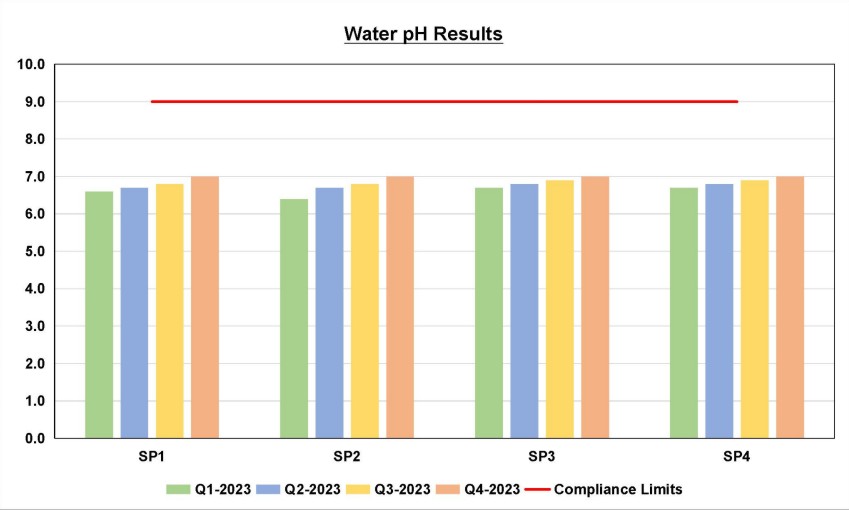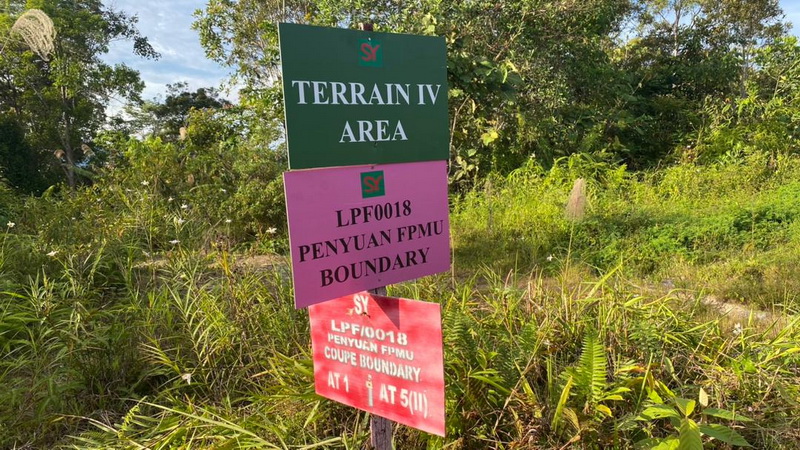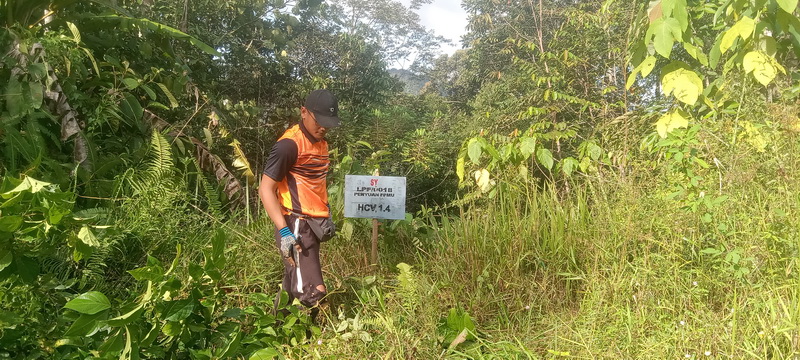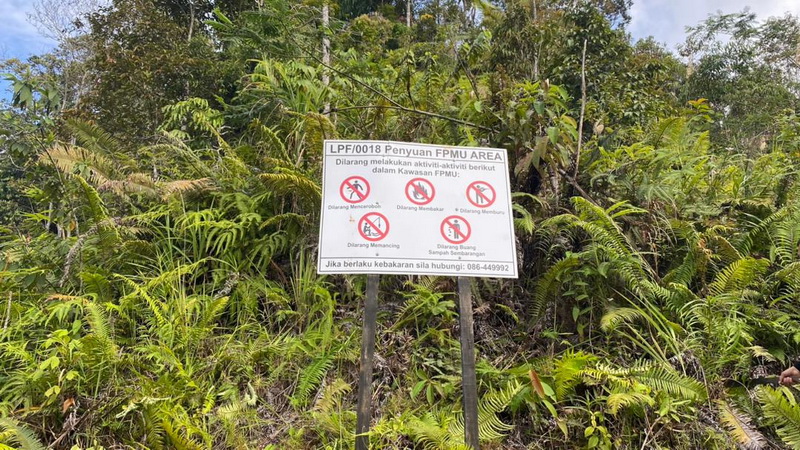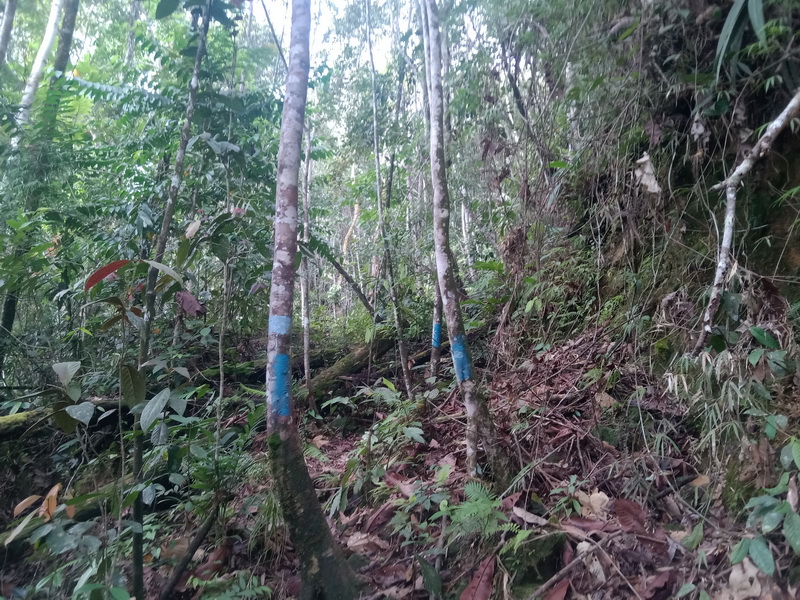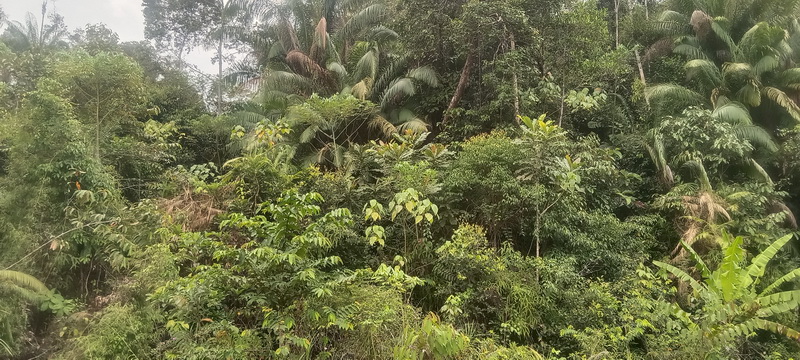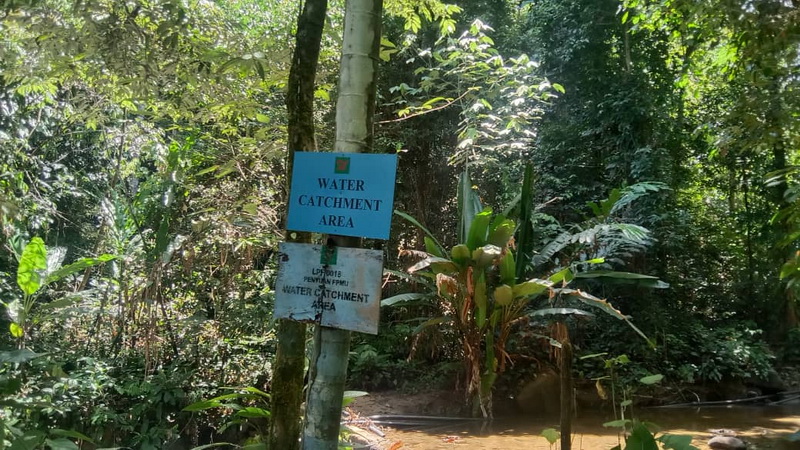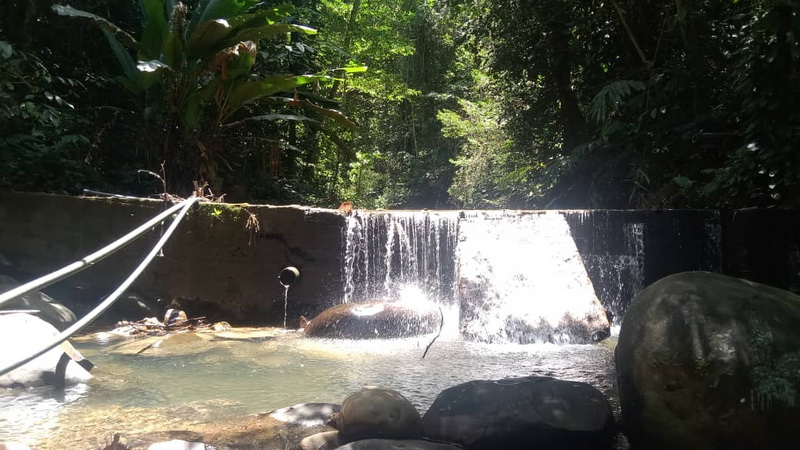SHIN YANG FORESTRY SDN. BHD.
PUBLIC SUMMARY
FOREST PLANTATION MANAGEMENT PLAN
FOR
LPF/0018 – Penyuan FPMU
(VERSION 09 - Revised on April 2024)
1. INTRODUCTION OF PENYUAN FPMU
Figure 1.0: Location of LPF/0018-Penyuan FPMU
The project area is titled Penyuan Forest Plantation Management Unit (FPMU) which is part of License for Planted Forest LPF/0018: Penyuan Estate that commencing from 19th November 1999 to 18th November 2059. This FPMU is located northwest of Belaga Town in Belaga District, Kapit.
From the total 195,126ha of LPF0018 area, the Penyuan FPMU area only covering an area of 15,261 ha (see Figure 1.1). The coupe includes in FPMU are AT1, AT2, AT3, AP4-I/AT4(I) and AP4-I/AT4(II). About 27% from the total FPMU area is planted with Industrial Tree Planting (ITP), 50% is Enrichment planting areas, and the balance of 23% as unplanted area which is reserved in situ for buffer, green belt area, natural forest and etc (Table 1.0).
Table 1.0: Details of Penyuan FPMU area
The Penyuan FPMU area is covered mainly by logged over hill mixed Dipterocarp forests. The logging licenses covering the whole site of Sector A is T/3282 and this logging activities is still going. A network of logging roads was built to cover the whole area within the project site which is presently used by the relevant timber licensees.
The FPMU is about 50 km north of Belaga town and about 30km west of the Asap Resettlement. The approximate grid reference of the site is between latitudes 02o56.0’N - 03o02.43’ N and longitudes 114o10.0’E - 114o25.61’E.
Penyuan FPMU is mainly drained by Batang Belaga and its tributaries. Being an undulating and hilly area, numerous small streams are also found within the site.
The northern side of the project area is bordered by Oil Palm Plantation of Samling Plantation Sdn Bhd and PASB Plantation Sdn Bhd. The west side is bordered by Pusaka-KTS Forest Plantation.
2. POLICY OF COMMITMENT
3. MANAGEMENT OBJECTIVE
The management objective of the plantation is to enable a continuous supply of timber for downstream processing activities (plywood, veneer and particle board) especially for Shin Yang Group of wood processing plants. There is also the global sentiment to source for timber from planted forest instead of from natural forests. Planted forests have the advantage of planned and timed production, uniformity of logs and automation in the processing plants. They will also help to reduce harvesting pressure on the remaining natural forests.
Besides that, forest management also has the following objective:
- Optimum utilization of forest resources while ensuring ecological function
- Regulation of harvest on a sustainable yield basis
- To reduce environmental impact
- To promote natural forest conservation, restoration and enhancement within FPMU
- To maintain or enhance the long-term social and economic well-being of workers and local communities
4. MANAGEMENT SYSTEM
4.1. Species Site Matching
According to the available soil and terrain information, about 70% of the areas can be use for tree plantation. Such suitable areas comprise mainly Kapit, Merit and Bekenu soils.
The Red-Yellow Podzolic soil are generally suitable for cultivation and tree plantation. The main limitation are steep topography and erosion hazard. Slope in excess of 25º required conservation measures for their utilization such construction of terraces.
The general guides for the correlation of soil and terrain and the land use options shown in Table 2.0.
Table 2.0: Correlation of soil and terrain and the land use option
4.2. Choice of Species
However, the Penyuan FPMU will concentrate on those fast-growing species that are widely cultivated nowadays in forest plantations and which are suitable for use in the Shin Yang Group’s existing and future plywood factories. The predominant species to be established are Acacia mangium and Falcataria moluccana (previous known as Albizia falcataria).
4.3. Nursery Practice
Nursery operations will follow the existing practiced, i.e. use of media, potting medium, transplanting and seedlings maintenance. However, improvement will be made as along the operations carried out. To improve plant quality and nursery system, we had improved in many aspects such as adopt a tray system (96-cell), tray benches to suit the tray system, drainage, water system, and irrigation. Our nursery also equipped with tray return and cleaning area for our tray hygiene purpose.
Prior to sowing, all seeds will undergo treatment to ensure that all the seed to be sown are good quality.
During the nursery stage, all seedlings pass through 3 stages of selection. Seedlings that are unhealthy, abnormal, and found to be infected with pests and diseases will be rejected. After 10 weeks in the nursery, the seedlings will be transferred to site for planting.
4.4. Site Preparation
There is two ways of land preparation methods, namely open clearing for Industrial Tree Planting and Under Canopy Slashing for enrichment planting. Open clearing is applied for flat to mild terrain areas that does not exceed 25º slope. Under canopy slashing is used for steeper terrain and fragile areas to avoid soil erosion, land slide etc.
4.5. Planting
Field planting will commence when the seedlings are more than 30cm tall or about 3 months old. Only mature and well harden seedling can be planted. The planting will be done manually using hoe. Where the soil is compact, more extensive holing or site cultivation may be necessary. The planting holes will be dug immediately prior to the planting operation.
4.6. Harvesting System
Harvesting will commence at 10 years after planting and only permitted in block that have been endorsed by the Forest Department Sarawak (FDS) under operation 5 of the Permit Harvesting Coupe (PHC). All the trees within the planting block will be clear felled except protected and conservation areas. As the land is to be used for establishing a second rotation of ITP, low ground impact harvesting system will be used. This to minimize soil compaction so that there will be good tree growth after planting.
5. FOREST RESOURCE DESCRIPTION
5.1. Geology Soil
For soil distribution, the main soil types in Penyuan FPMU are Kapit soils and Kapit/Tutoh/Bekenu soils. With that, the site is dominated by skeletal soils. Skeletal soils commonly find in hilly areas.
5.2. Growing Timber Stock
The forest in FPMU area is a hill mixed dipterocarp forest that has been disturbed by logging and agricultural activities. There is only limited large diameter tree were recorded in the area as it was heavily logged over before, leaving only several tree which either too small for harvest or has no economic value.
5.3. Non-timber Growing Stock
The non-timber stock such as fruits and nuts, vegetables, fish and game, medicinal plants, bamboo, rattans, and a host of other palms and grasses are still available and can be found at at remaining natural forest areas.
Due to sparse distribution, the forest floor was bright with little litter and some herbs, climbers and grasses, e.g. Blechnum orientale (paku kelidang), Uncaria spp. (akar rarak), and Zingiberaceae. Two big palms were found on steep slope, i.e. Pholidocarpus majadum (jaong) and Eugeissona utilis (pantu bukit).
6. ENVIRONMENTAL LIMITATION
Penyuan FPMU site is undulating to hilly condition with slope of 8° to more than 30°and altitude between 750 m to 3750 m above sea level. Deep valleys are a common structure within the areas especially around the northeast areas. The central terrain is undulating. This terrain factor causes difficulty to access some area during the wet season (October until January) and the steep terrain has high potential to soil erosion during heavy rain.
7. LAND USE
Penyuan FPMU area was formerly under the Forest Timber Licence T/3282. This forest plantation area was previously covered mainly by logged over hill mixed Dipterocarp forest. The northern side of the project area is bordered by Oil Palm Plantation of Samling Plantation Sdn Bhd and PASB Plantation Sdn Bhd. The west side is bordered by Pusaka-KTS Forest Plantation. No permanent local settlements are found within the site. There is no legal claims of NCR land within FPMU areas.
Development of the plantation involves several stages such as project site investigation, nursery establishment, plantation buildings and amenities, land preparation, construction of infrastructure, field establishment, maintenance and abandonment and replanting.
8. SOCIO-ECONOMIC CONDITION
A total of 10 longhouses are located nearby FPMU. The profile of the longhouses were shown in Figure 2.0. The main communities living here are the Penan and Kenyah. Table 3.0 show the summary of the 10 longhouses that are affected by the development of the Penyuan plantation activities.
Table 3.0: Profile of the Asap resettlement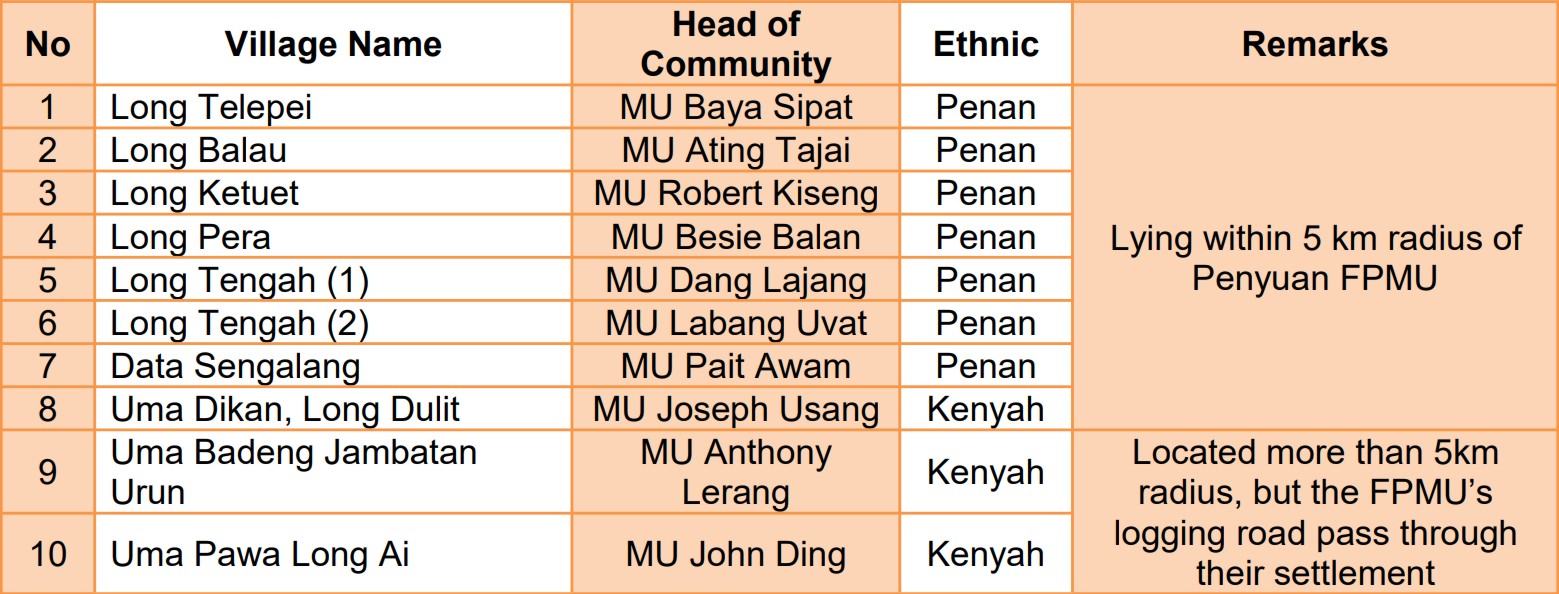
The people of the community practices distinctive social-cultural systems which stems on their native culture which was passed down from previous generations. Although they mainly speak their own language on daily basis, some of them are also conversant in other languages such as Bahasa Melayu and Bahasa Iban.
Based on SIA assessment, the main occupation of the people was farming. The main crops planted were hilly paddy which grown by shifting cultivation and some fruit trees. The local community also receives some form of farm assistance from the Department of Agriculture. Livestock such as pigs and chicken are commonly raised in small scale. About 86% were farmers while the rest working with nearby companies.
A primary school and secondary school located at Sg. Asap while another primary school located ar Long Urun. Some public facilities or services such as clinic, post office, police station, district can found at Sg. Asap. There was no direct electricity supply to the longhouses. The people used their own generator. The longhouses have been provided piped water by government.
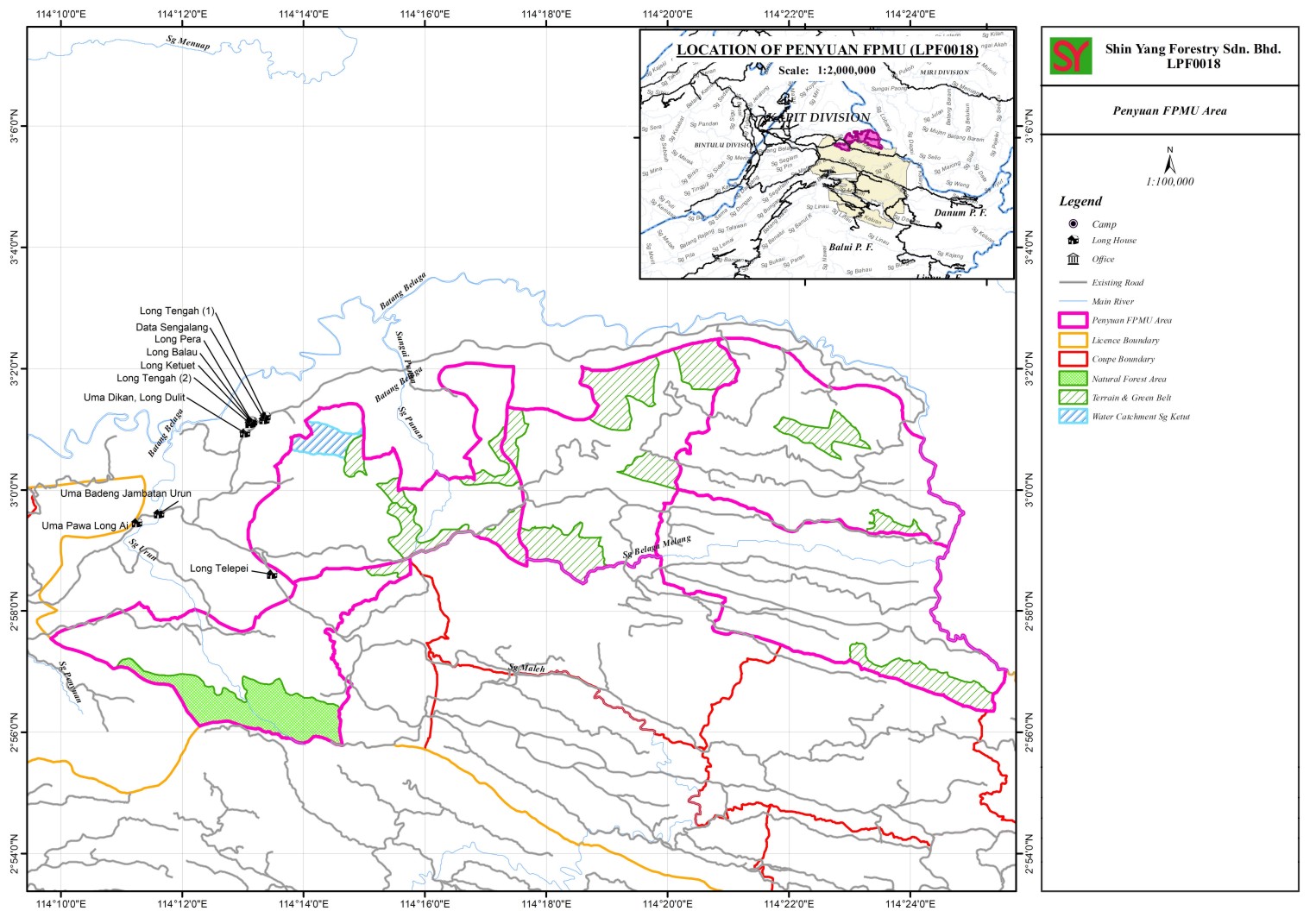
Figure 2.0: Location of the longhouses within Penyuan FPMU
9. SILVICULTURE
9.1. Thinning
Some areas will also undergo liberation thinning to provide more growing space for better trees to grow at their maximum rate, yielding the next harvest in as short a time as possible.
Thinning involves in two stages:
- Upon canopy closing - Basically, this stage applies when the trees reach age of two to three years for fast growing species.
- Based on the PSPs data - This thinning practice will be applied to boost the tree growth if the trees in plantation site still in small diameter as it already reach age five to seven years.
9.2. Pest And Disease Control
In the event that pests or disease are found to affect the Plantation, and the management has decided that control measures are to be implemented, the control measures will include:
- Changing the species planted in the affected areas or use more resistant clones;
- Eliminating the organism or known sources from the plantation area;
- Avoiding conditions that are conducive to the survival of the pest/ disease organisms;
- Adjust and refine silvicultural practice;
- Direct control using insecticide, fungicides or other biocides; and
- Biological control using natural enemies of the pests.
9.3. Weed Control
For the first cycle maintenance, weed and low shrubs which are part or the indigenous ground covers need to be slashed back at regular intervals during the initial 3 month of after planting because some species do not tolerate well competition from weeds (Grass height must not more than half height of the planted trees). For the second cycle of weed control is depend on the site condition.
10. HARVESTING PLAN
10.1. Cutting Limits
The is no minimum tree size enforced on the harvesting of the standing ITP. All the trees at the permitted block will be clear cut.
10.2 Period Of Harvesting
Based on the present research data available from PSPs data and propose diameter cutting limit (minimum 10 cm DBH), the growth rates and rotation length for harvesting will commence at 10 years after planting and replanting will be carried out for the next rotation.
10.3. Annual Allowable Cut (AAC)
The allowable cut is based on area control, in accordance with the approved General Harvesting Plan (GP) of the licensed area. The company is proposing 10 years cutting cycle for the whole Penyuan Estate area (include certified and non-certified area), which is 5 years within certified area (FPMU area) and the next 5 years will be move to other coupes outside certified area (still within Penyuan Estate). Based on the 1st rotation planting record the ACA within Penyuan FPMU for a period of 5 years is 821.40ha/year.
11. MONITORING OF FOREST GROWTH AND DYNAMIC
Proper permanent sample plots have been set up to monitor performance of trees, growth rate of the planted forest and yield of all forest products harvested so that useful data could be procured for estimates of stocking size, quality and stand volume of the plantation. The location of each plot is randomly chosen within the FPMU area and will be measured annually. Pest and disease information is also collected at the time of assessment.
12. ENVIRONMENTAL SAFEGUARD
12.1 Environmental Impact Assessment (EIA) Report
The Environmental Impact Assessment report for the LPF0018 forest Plantation "Environmental Impact Assessment " was approved by NREB Sarawak dated 28th January 2000.
12.2. Environmental Monitoring Report (EMR)
The environmental monitoring and review is done by consultant and submitted to the NREB quarterly. The monitoring includes water course quality monitoring.
12.3. NREB Verification and Inspection Visit of The FPMU
The NREB regularly carries out routine environmental inspection on the compliance to the Terms and Conditions of the EIA Report Approval document for the project area.
12.4. Patrolling by FPMU Holder
FPMU holder has been develop patrolling schedule to ensure the protected and HCV areas is remains intact, control encroachment, fire monitoring and to prevent/control unauthorized activities in forest plantation areas.
13. IDENTIFICATION AND PROTECTION OF RARE, THREATENED AND ENDANGERED SPECIES
The guidelines used for identification and protection of ERT species of forest flora and fauna including features of special of special biological interest area:
- Wildlife Protection Ordinance 1998
- Sarawak Plant Red List
- A Master Plan for Wildlife in Sarawak 1996
- HCVF Toolkit for Malaysia
- Orang Utan Strategic and Action Plan
- The IUCN Red List of Threatened Species at www.iucnredlist.org
Sign boards has been prepared and installed at strategic locations. The entry to FPMU area shall be limited to the unauthorized person. A schedule for monthly patrol for the year has been developed to control fire, hunting, fishing and collecting activities in the forest plantation areas.
Signage detailing the Director of Forest Circular 6/99 have been erected in front of the entrance detailing 4 items:
- Employees of the Timber Companies are not to hunt in the licensed areas while they are in the employ of the company.
- Company vehicles are not to be used for hunting or for carrying meat of wild animals.
- Selling of wild animals or meat of wild animals is not allowed in the licensed area.
- Feeder roads are to be closed after the final block inspection to prevent further entry of vehicles.
14. HIGH CONSERVATION VALUE (HCVs)
The assessment of High Conservation Value Forests (HCVFs) within Penyuan FPMU was carried out by consultant based on HCVFs Toolkit Malaysia. The assessment was conducted on April 2015. Sub-teams assessed biodiversity, ecosystem service value, social and cultural values and found that all six major values listed in the HCVF Malaysia Toolkit (2009) are present.
As a result of the assessment, HCV 1.1 was not present in the plantation area. There were sign of Endangered (EN), Critically Endangered (CR) or Vulnerable (VU) flora and fauna (HCV 1.2) observed during the assessment. There were 10 endemic species of flora and 3 endemic species of fauna found in FPMU (HCV 1.3). These endemic flora and fauna species are common and significant concentrations or distributions are already protected within the TPAs in Sarawak.
HCV 1.4 which served as critical temporal use for wildlife such as food source also observed within project area. Although the surrounding of project area have been developed for tree plantation and oil palm plantation, the areas which served as an important refuge for wildlife still available(HCV 2).
HCV 3 was not present in the plantation area. Terrain IV have been identified within the project area remains as an important watershed to the main rivers which helps to mitigate floods and provide clean water to Penyuan camp and nearby villages (HCV 4.1). To maintain and enhance this value, river buffer has been established and maintain according to DID/NREB guideline. HCV 4.2 has been identified in the project area and river buffer has been established to control and minimize erosion. Barrier of destructive fires also been identified in the project area (HCV 4.3).
A total 10 local community settlements are located adjacent to Penyuan Tree. The communities from the 10 settlements are depending on the forest resources available in the project area to meet their basic needs. Figure 3.0 show HCV identified within Penyuan FPMU areas
Management of HCVs Areas:
- Retain Terrain IV and other forest area such as water catchments and river buffers/wildlife corridors.
- Establish and maintain wildlife corridors and rivers.
- Plant food resources for animals in and around the wildlife corridors and river buffers.
- Ensure that trees felled fall away from river bank buffers.
- Maintain security post at the entrance of plantation camp.
- Prohibit plantation workers from hunting.
- Establish buffers for each salt lick.
- Keep road and skid trail density to minimum to reduce environmental impacts.
- Regular consultation with local Penan and Kenyah people who are affected by the forest operation.
- Identify and mark the location of burial ground with the local people.
Monitoring of HCVs Areas:
- Wildlife corridors and river buffers established and maintained.
- Put up warning signs on hunting and posters on protected plants and animals.
- Decrease the number of outsiders to enter the areas.
- Initiation of environmental education programs.
- Continuous village consultation.
- Burial ground preserved.
- Identification and Protection of Rare,Threatened and Endangered Species. Rare, threatened and endangered species will be identified and protected by company.
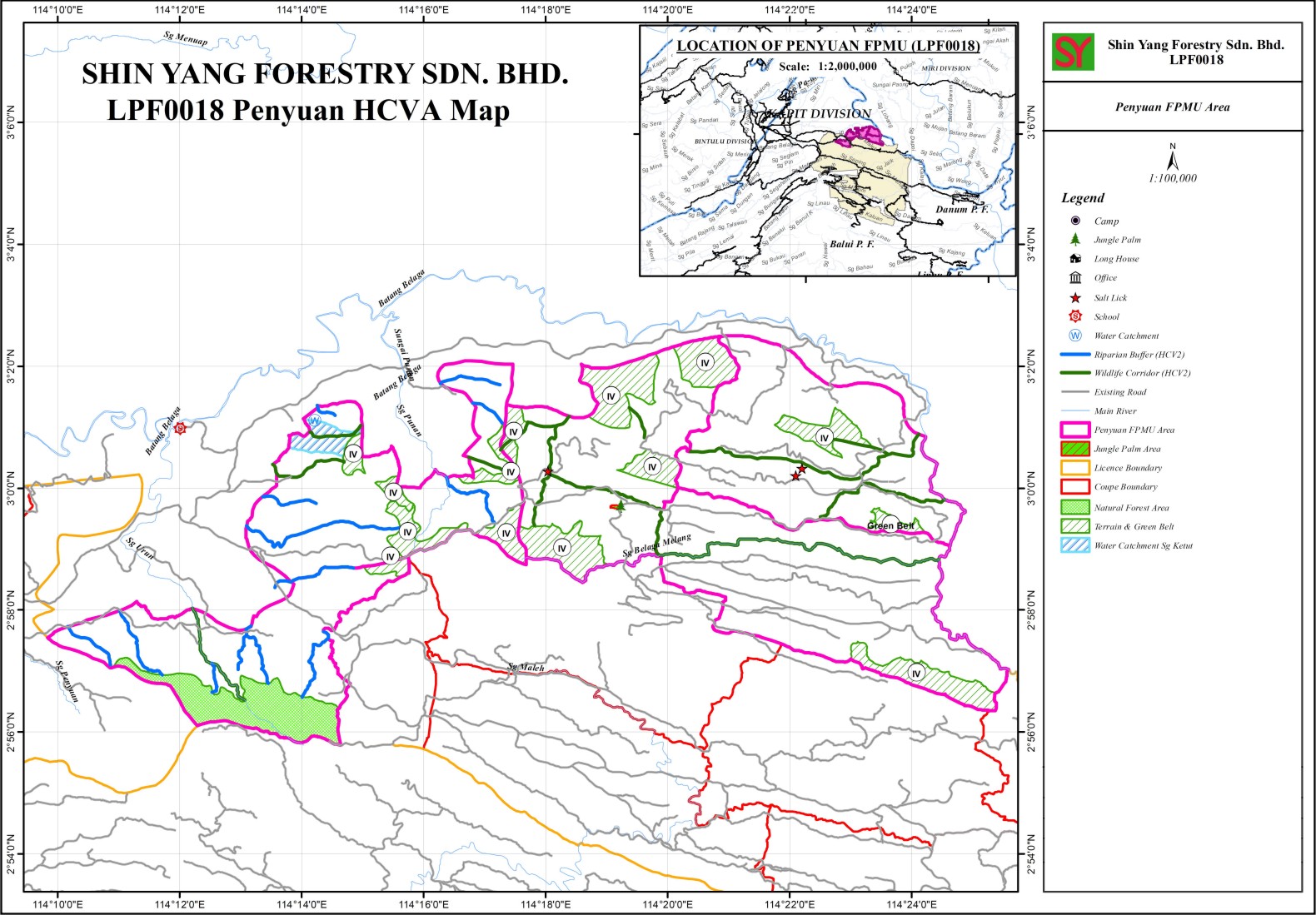
Figure 3.0: HCV area within Penyuan FPMU Areas
15. RESULT OF FOREST MONITORING AND ASSESSMENT
15.1. Yield Of All Forest Products Harvested
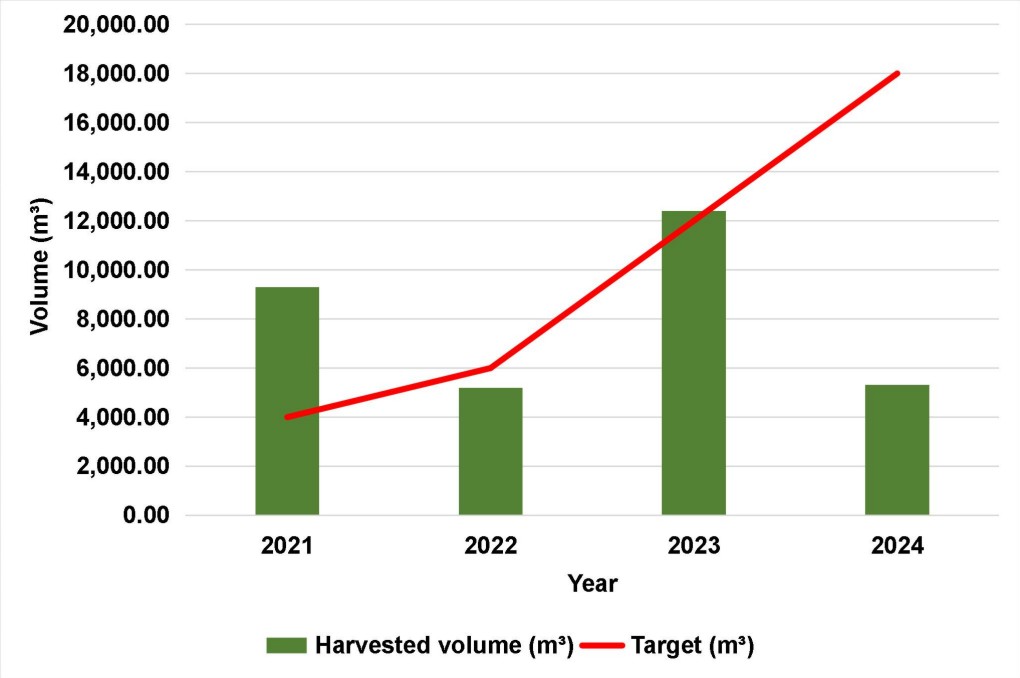 Figure 4.0: Yield of forest product harvested LPF/0018 Penyuan FPMU
Figure 4.0: Yield of forest product harvested LPF/0018 Penyuan FPMU
15.2. Growth Rates Of The Planted Forest
Based on data collected from the established PSPs (date of assessment, August 2022), the average MAI for P. falcataria was 10.48m³/ha.
15.3. Composition And Observed Changes In The Flora And Fauna
15.3.1. Flora
Based on the FPMU monthly patrolling record for the year 2023, the previous stream buffer zone/wildlife corridor, Terrain IV, natural forest areas, and other protected areas were maintained undisturbed. There has been no further study on the changes of flora due to a lack of expertise.
15.3.2. Fauna
The fauna species have been identified by our surveyors during monthly patrols. For the year 2023, a total of 44 species were identified during these patrols. Some of the species could not be identified due to a lack of expertise.
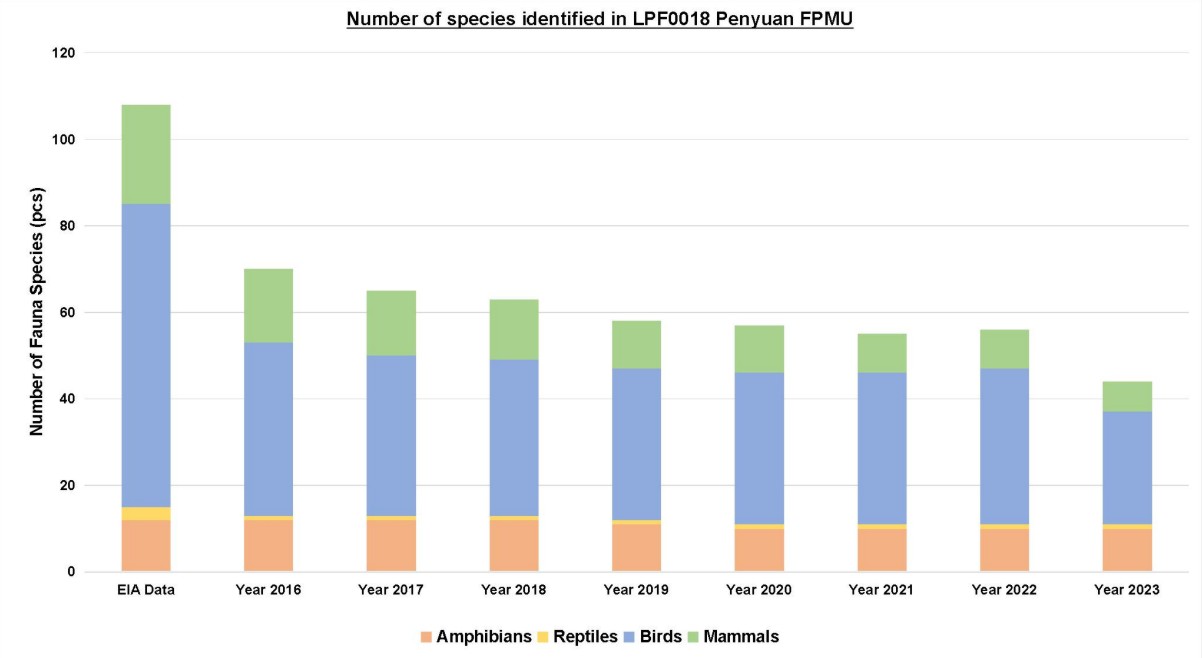
Figure 5.0: Number of species identified in LPF0018 Penyuan FPMU through sightings
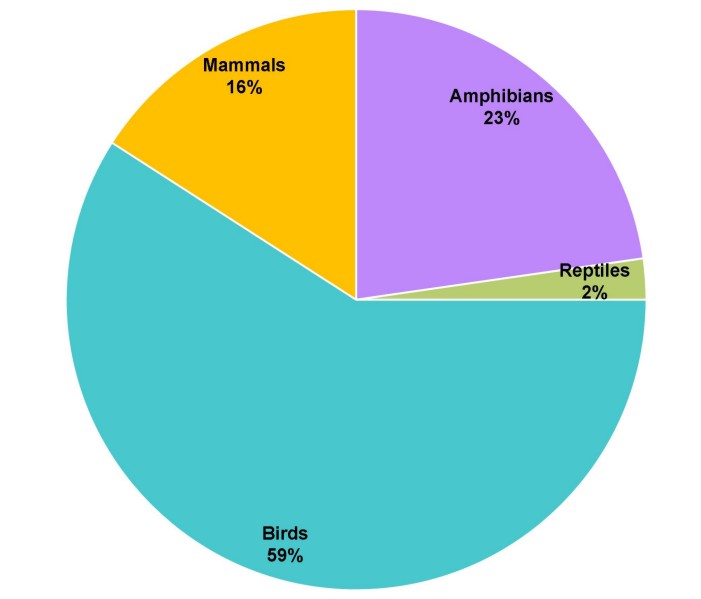
Figure 6.0: Percentage of Fauna Species identified in LPF0018 Penyuan FPMU in Year 2023
15.4. Environmental And Social Impacts Of Harvesting And Other Operation
15.4.1. Environmental impacts
Based on the EMR Report for year 2023, (EMR reference No.: NREB/6-3/2G/5), the results of the water quality analyses at SP1 to SP4 are tabulated in Figure 7.0 to Figure 17.0.
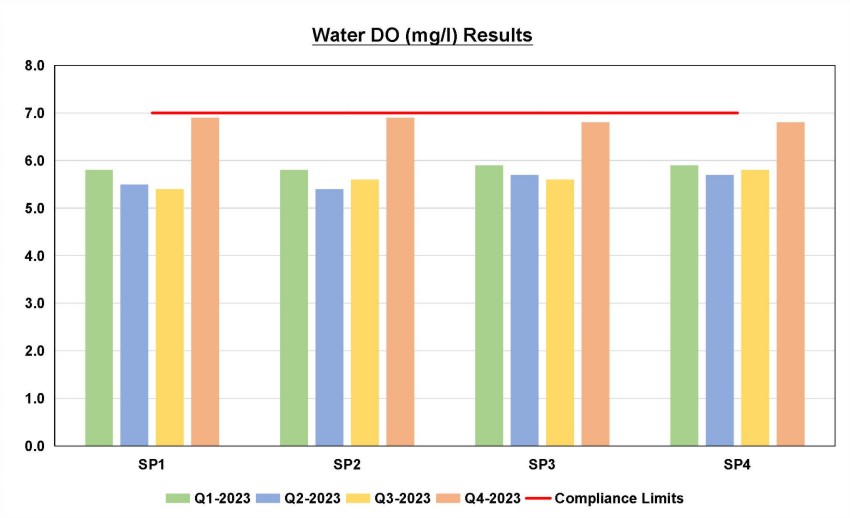
Figure 8.0: Water DO (mg/l) Results
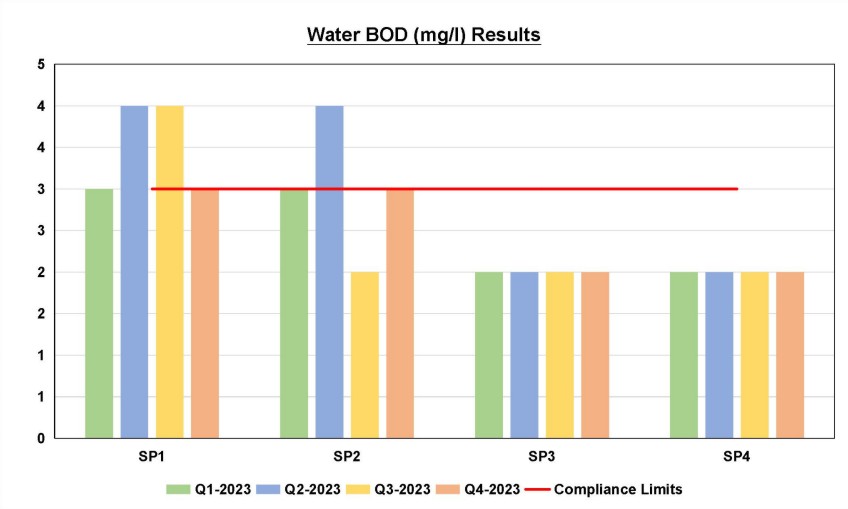
Figure 9.0: Water BOD (mg/l) Results
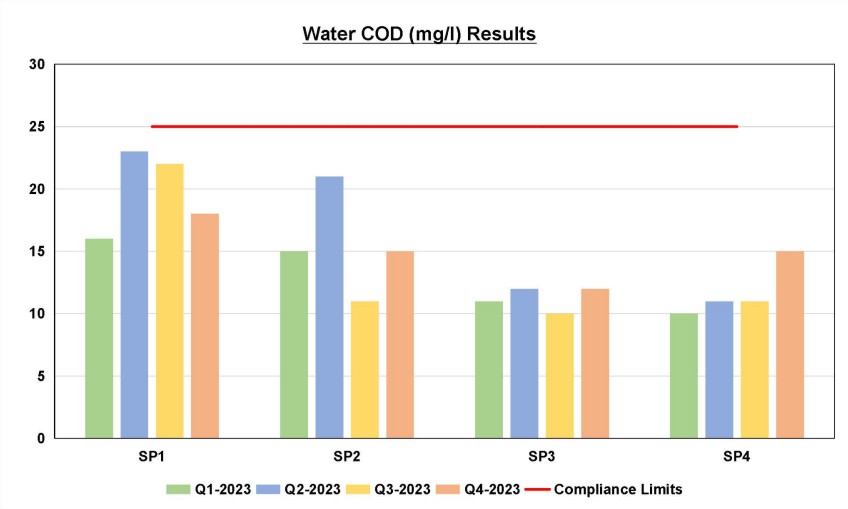
Figure 10.0: Water COD (mg/l) Results
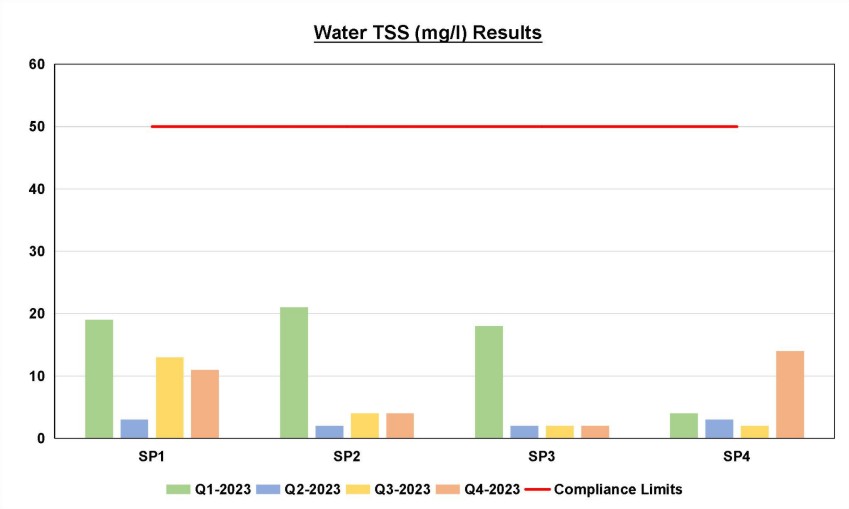
Figure 11.0: Water TSS (mg/l) Results
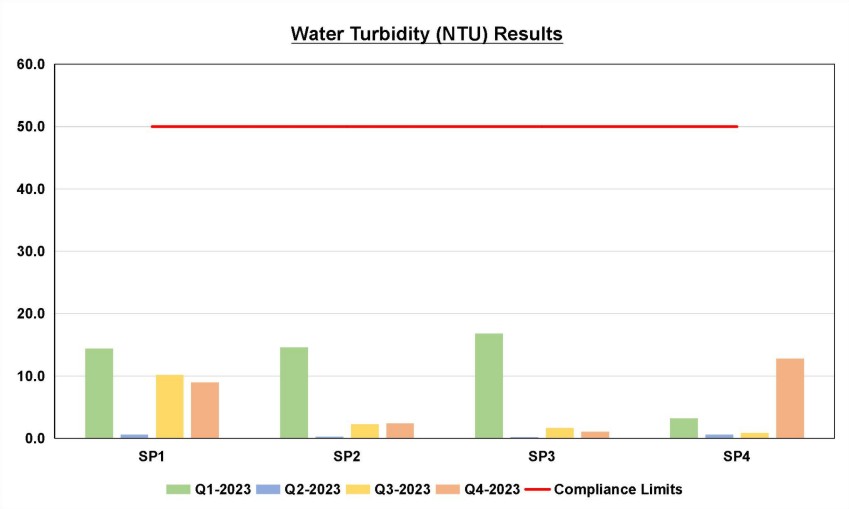
Figure 12.0: Water Turbidity (NTU) Results
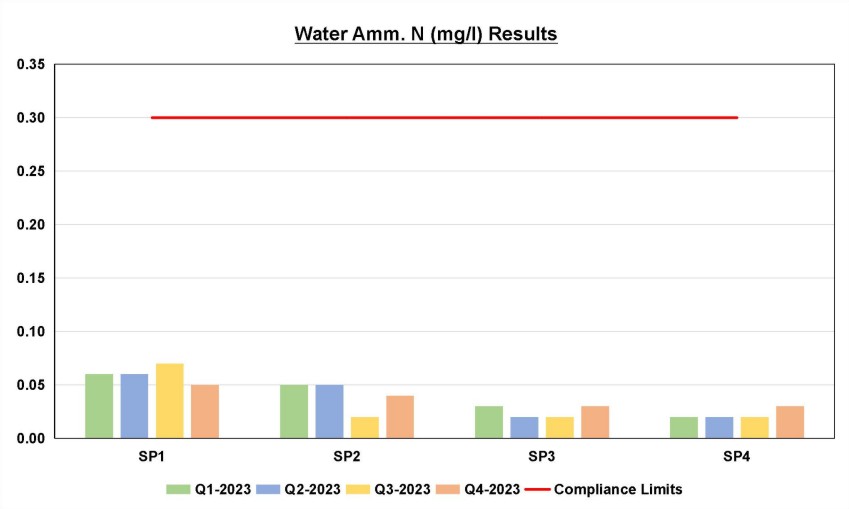
Figure 13.0: Water Amm. N (mg/l) Results
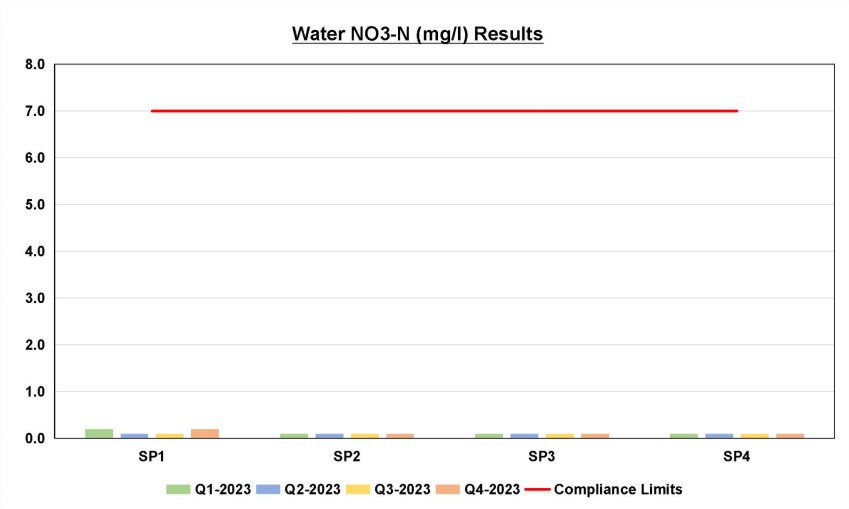
Figure 14.0: Water NO3-N (mg/l) Results
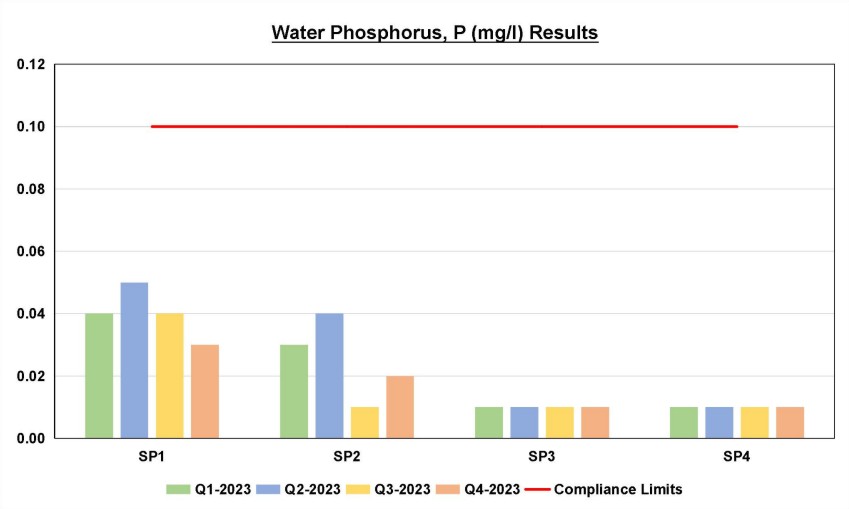
Figure 15.0: Water Phosphorus, P (mg/l) Resultsi
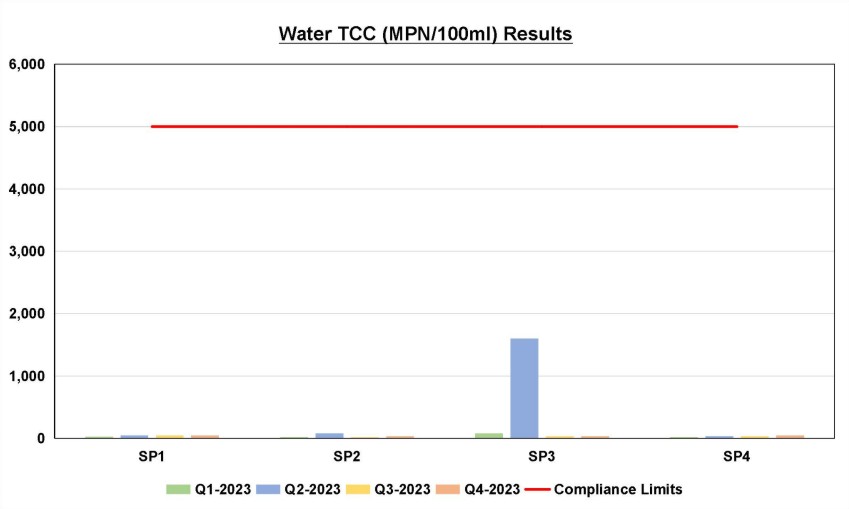
Figure 16.0:Water TCC (MPN/100ml) Results
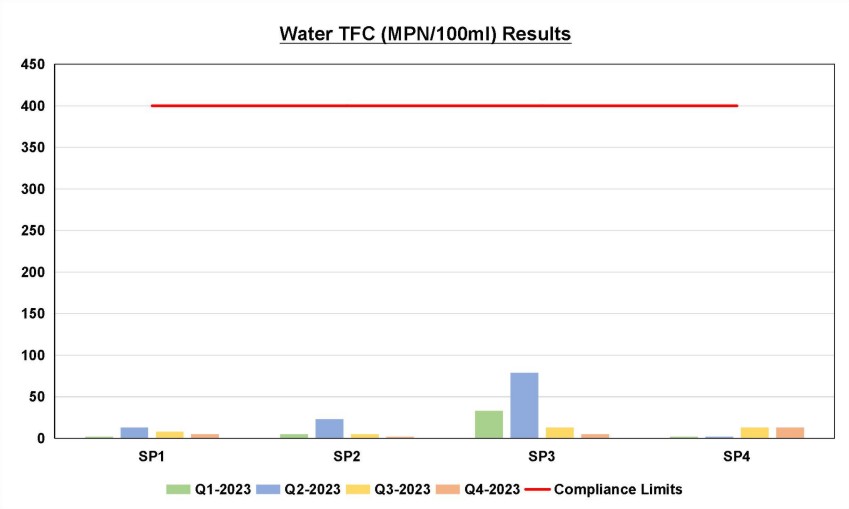
Figure 17.0:Water TFC (PMN/100ml) Results
Biodiversity Conservation and Retention of Buffer Zone
The major drainage systems in the Plantation were in place. Sufficient riparian buffers with
vegetation had been set aside along the major waterways such as along Sungai Penyuan, Sungai
Seping.
Domestic Waste Management
Sanitary toilets with septic tank facilities had been provided. The domestic wastes generated at the
workers’ camps are collected and dumped in a pit within the Plantation
Workers Health and Safety
No major communicable or vector-borne disease had been detected and 1 major occupational
accidents had been reported for year 2023.
Pest and Disease Management
Pest and disease are not a serious problem in Penyuan Plantation
15.5. High Conservation Value Area (HCVA) monitoring result
| HCV | Result of Monitoring Until June 2023 |
|
HCV1 - HCV 4 |
|
| HCV 5 & HCV 6 |
|
15.6. Social impacts
There are no complaints, land disputes or conflict encountered between local communities and FPMU since year 2014 until year 2023. There is no any record of NCR claims within the FPMU areas. Locals such as those from community living within and adjacent FPMU areas be given preferences job. All the workers engaged were staying in the quarters. The FPMU has been taken initiatives to increase workers recruitment from local’s communities thru direct verbal communication with villages and also posting the job advertisement at the Longhouses notice board.
As part of the social contribution the management of the FPMU had provided free transportation to the local communities on requests, foods and drinks for special occasions, repair of access roads to longhouses. The management had contributed RM26,487.50 to its CSR project for for the year 2023. The CSR activities are mainly on infrastructure, donation and aids.
15.7. Cost and productivity of forest management
Cost and productivity of the company’s operation was confidential. Please refer to the management for details and information.
16. LIAISON COMMITTEE
Liaison committee responsibility is as below:
- Issues over tenure claims and use rights.
- Conflicts pertaining to the recognition of the legal and customary rights of the local communities.
- Measures threaten or diminish resources or tenure rights of the local communities.
- Protected the sites with special cultural, ecological, economic or religious significance to the local people.
- Long term social and economic well-being of forest workers and local communities.
- Grievances and provide fair compensation in case of loss or damage affecting the legal customary rights or livelihoods of local people.
- The use of the forests’ multiple products and services to ensure economic viability with the environmental and social benefits.
- Carry out annual consultation to maintain the long-term social and economic well-being of local communities
17. COMMUNITY’S ISSUE RESOLVING
Any conflict and grievances between local community and company will be resolved according to Mechanisms to Resolve Local Community Issues (SYF / MC & I / P.09) by following the relevant laws (either federal or state laws) as below:
- Federal Constitution – Article 8 and 13
- Land Code (Cap. 81) – Section 5 and 6
- Human Right Commission of Malaysia Act, 1999
- All adat codified under the Native customs (Declaration) Ordinance, 1996, and any other adat recognised and enforceable by the Native Courts under the Native Courts Ordinance, 1992, and the Native Courts Rules, 1993
- Decisions of the Civil Courts pertaining to legal or customary tenure or use rights
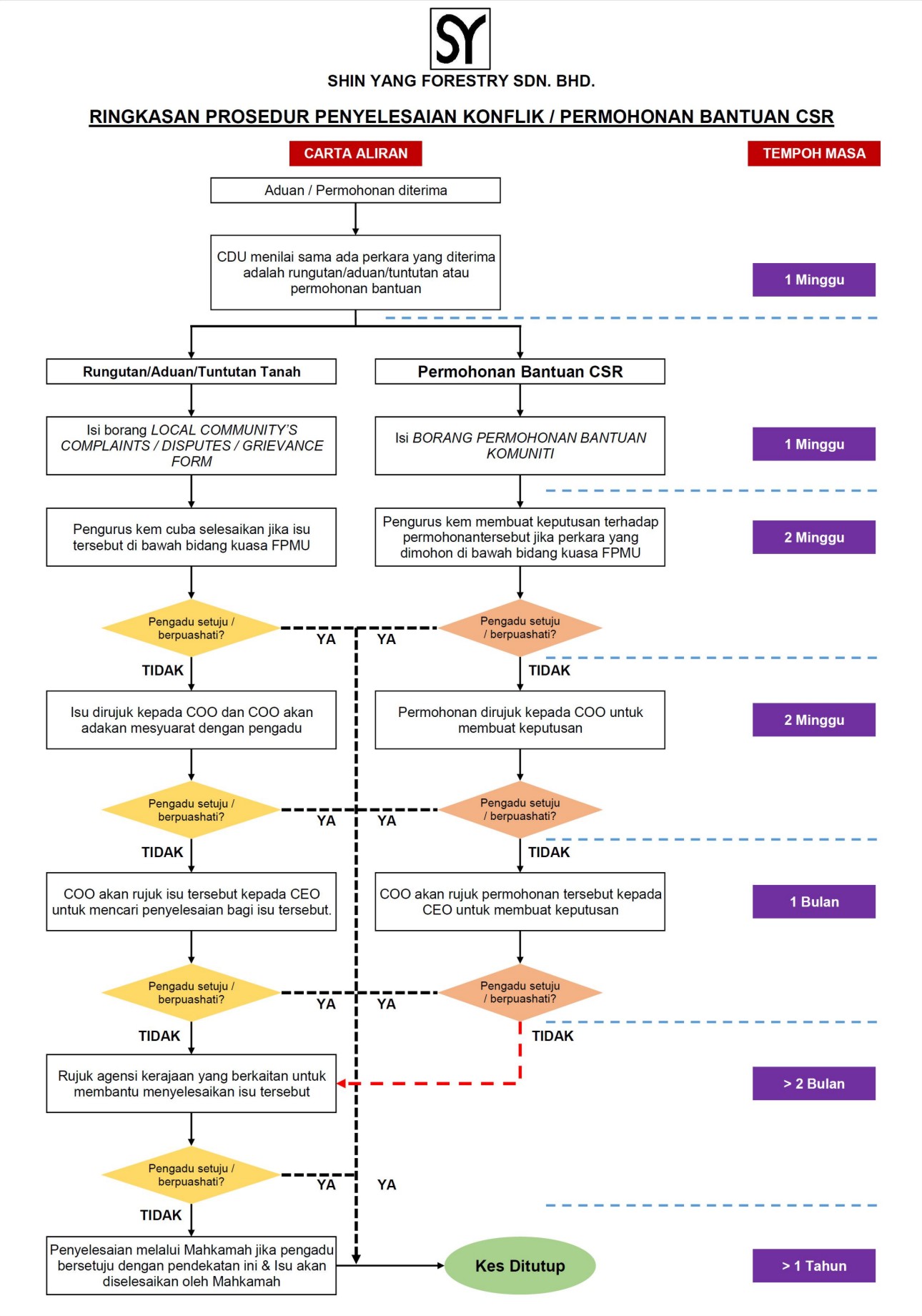 Figure 18.0: Grievance procedure process flow
Figure 18.0: Grievance procedure process flow
18. COLLABORATIONS & RESEARCH
Some studies will be parts of our research activities in this tree plantation project. Shin Yang Forestry Sdn Bhd with collaboration of Sarawak Forestry Department. Further research will be carried out for technical development of tropical tree plantation. The planned studies are as follows:
- Silviculture scheme and yield
- To determine the best harvesting time
- Biological disease control without agrochemicals
Other items in MoU:
- Permanent Sample Plot management
- Biological control and protection
- Study on carbon foot print
- Research and Development on Nursery, Tree Plantation and Reforestation
- Nursery practice and planted forest establishment
- Plant propagation techniques
- Biological control and protection
19. BUDGETARY
Annual budget includes the expenses of overall operations and activities namely; Nursery, Land preparation, Planting & Supply, Silviculture, Harvesting, Conservation & Monitoring, Transport & Infrastructure including social program, Amenities for workers, Safety, Staff training, research development etc.




